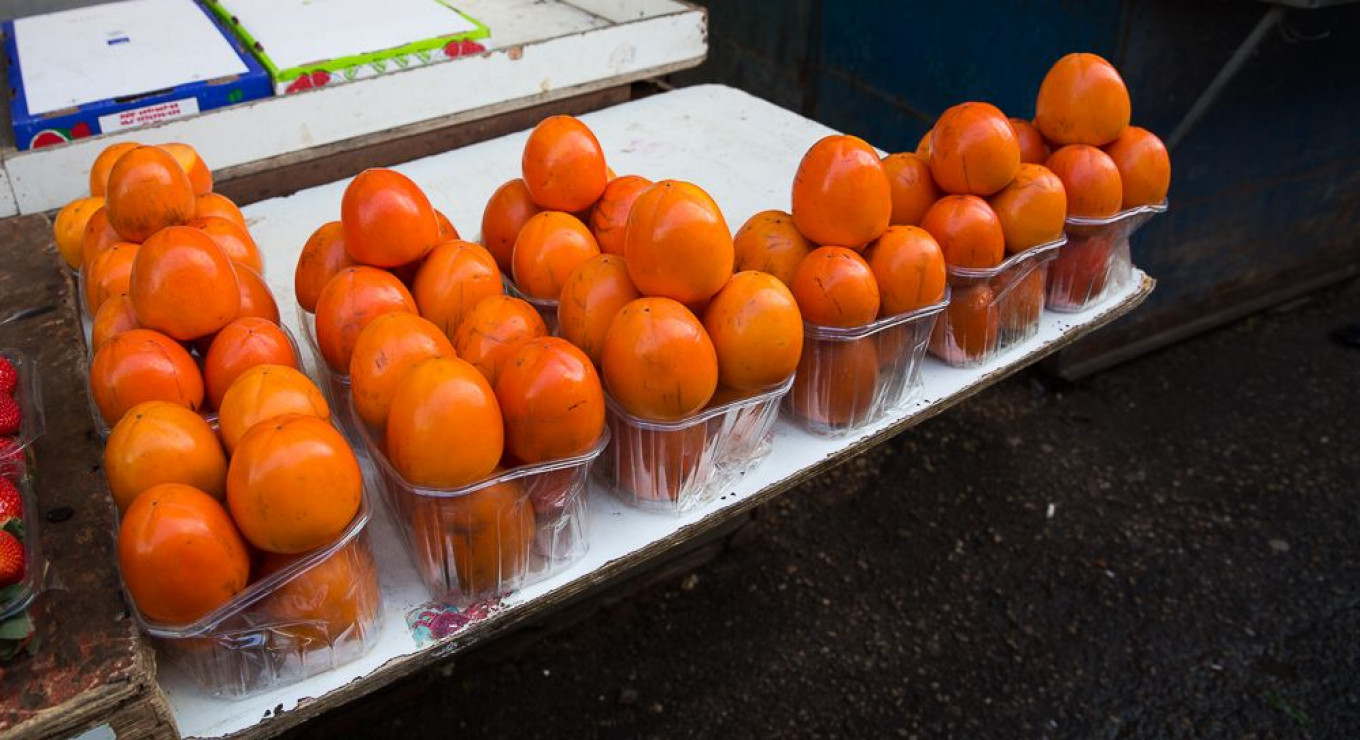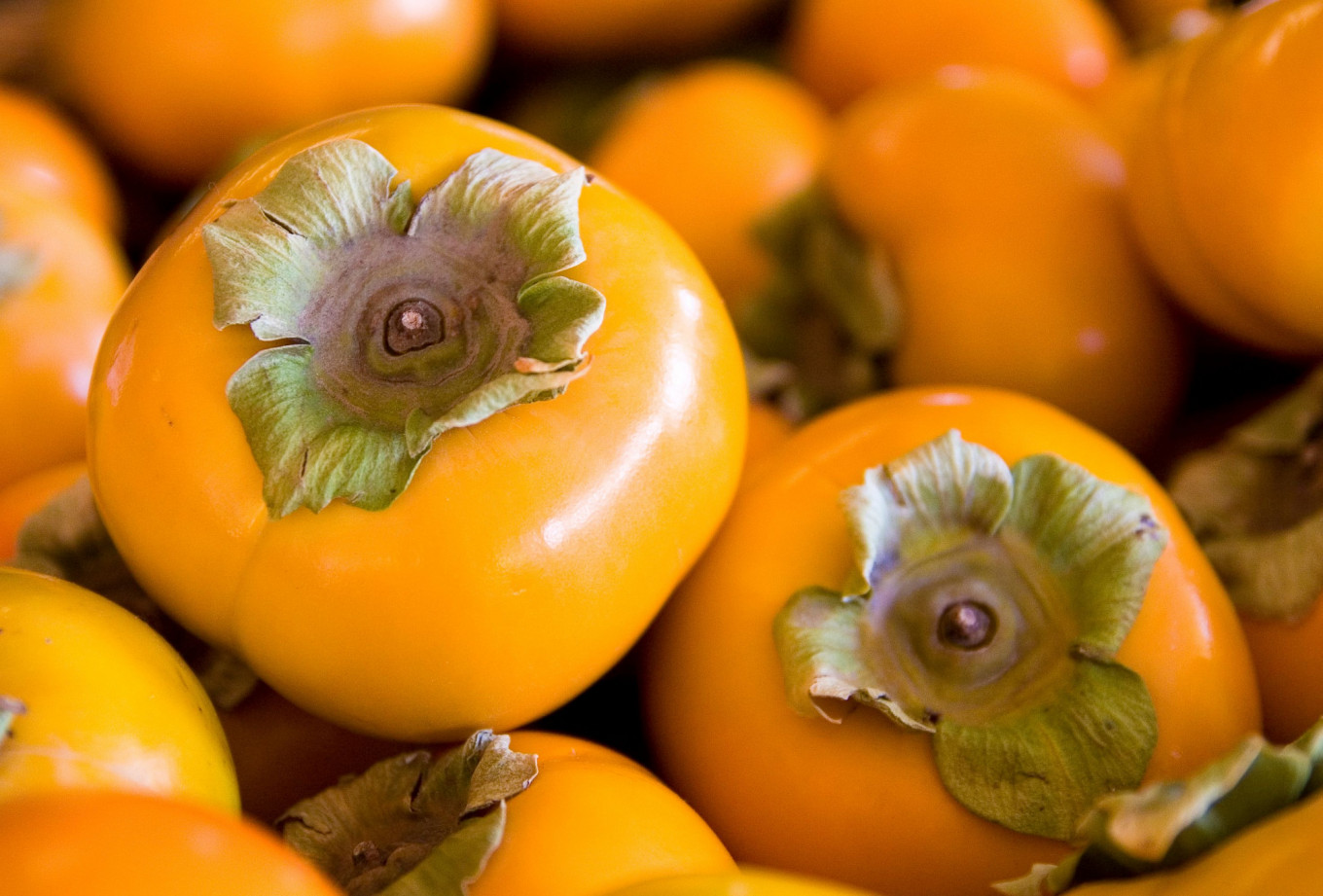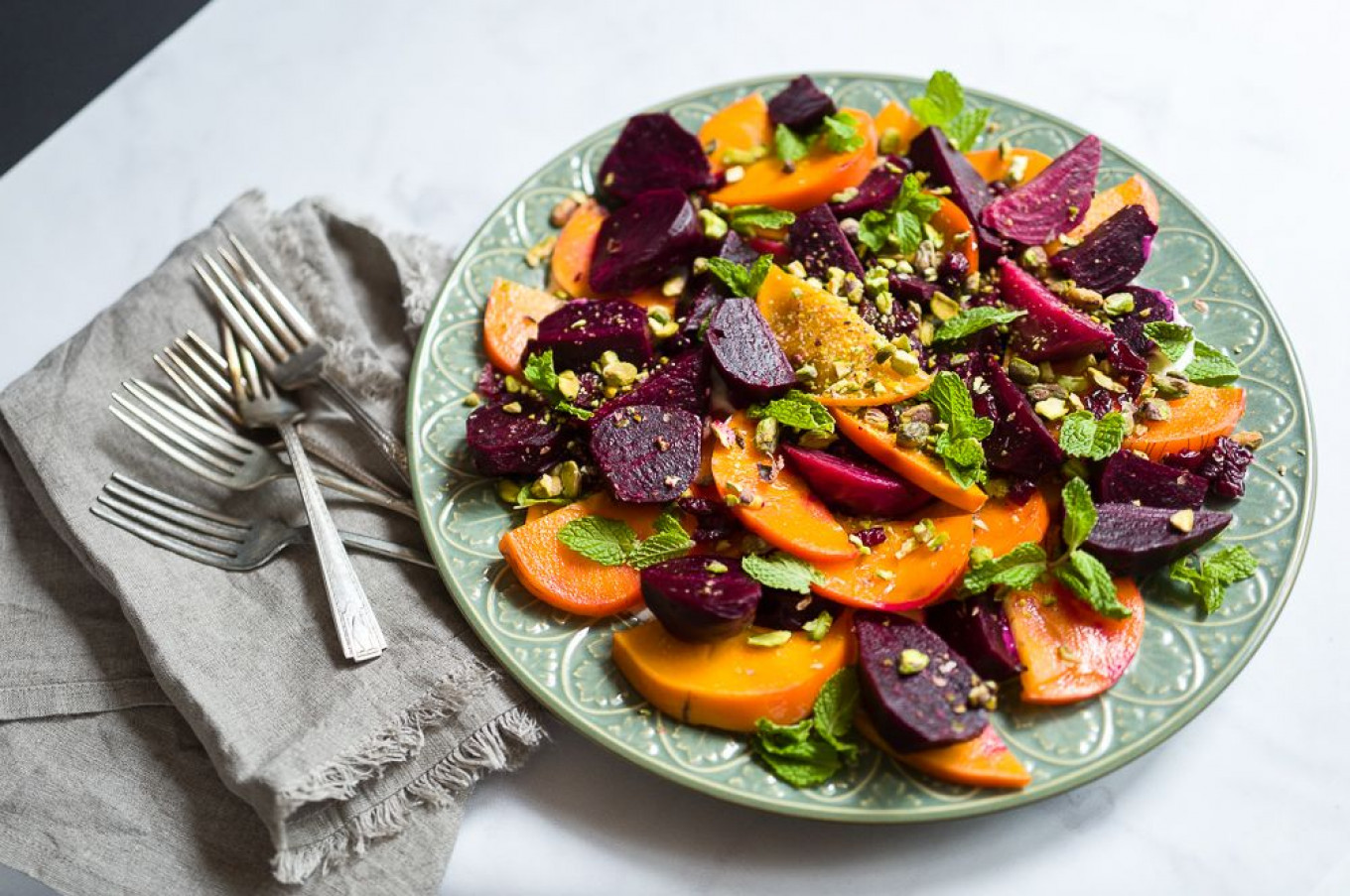Has this ever happened to you? You see something unusual at the market—you may have no clue what it is — but you pounce on it anyway, only to get it home and wonder, “now what?”
These are the inciting incidents of my culinary life in Russia. I fill my pantry with oddities that intrigue me, such as Georgian cheese, blood sausages, and pickled apples, brought home like exotic hunting trophies. This is very much a hit-or-miss approach to widening one’s culinary horizons, but invariably leads to some delicious encounters, which is exactly how I fell in love with persimmons.
I first encountered persimmons during the initial November of my Russian life, a chilly season, when despair is only one unpleasant encounter away. I glimpsed a strange fruit, its vibrant orange flesh glowing in the early evening gloom behind the smudged window of my local fruit and vegetable kiosk. Piled in perfect rows at the top of the window, the unknown fruit lorded it over the dirt-encrusted beets and potatoes, the tired-looking carrots and all the other limp and disinterested autumnal root vegetables, who had long given up the struggle to dazzle. I did not understand what they were, but anything that bright and jewel toned, must, I felt, be sweet, flavorful, and exotic — unlike the lackluster apples and halfhearted bananas lower down in the kiosk window.
The Russian name “khurma” left me none the wiser, so I looked it up when I got home and learned that these were persimmons. My only association was the name of one Crayola crayon in a box of 154, but it struck me as a profoundly romantic-sounding name: one that connoted something ancient and exotic, perhaps Biblical or mythic, a languid and luxurious fruit quite at home in a cornucopia positioned at the elbow of some Eastern potentate. When I cut the persimmon open, it was silky and juicy, with flesh several shades deeper and more intense than the ripest Nectarine, though it smelled more like a mango.
My first taste, however, was a disaster. The persimmon seemed perfectly ripe, the consistency of a peach approaching perfection firm but with a small give. But the persimmon slice immediately glommed onto my tongue as if it were a parasite, trying to suck all the moisture out of me. I immediately spat it out and decided that, once again, the kiosk salespeople had successfully duped the ignorant foreigner.

I might have given up on persimmons forever had I not stumbled across a jar of persimmon jam at the market the following week, sold by a vendor I’d known for a while and trusted implicitly (she was my main source for raspberry jam, which everyone knows is more important than penicillin.)
Svetlana laughed when I told her about my unfortunate encounter with the furry persimmon parasite.
“It wasn’t ripe enough!” she explained, laughing even as she shook her head at yet another lesson she had to teach the ignorant foreigner.
Svetlana explained that the conical-shaped astringent persimmons (also known as Hachiya) needed to be very ripe—they may even seem past their peak, or, as one food blogger friend puts it “like a half-filled water balloon,” which is the image I keep in mind when I probe Hachiya persimmons to test their readiness. When perfectly ripe, I can scoop out the flesh as I would an avocado or mango, and it is perfect for zapekanki (puddings), blini, puree, syrups, or persimmon bread or cake.
I also learned that non-astringent, or sweet persimmons (Fuya) are squatter and share a silhouette with the tomato. These are firmer, even when ripe, and are perfect for pickles and chutneys, and chunky jams.

Once I understood the rules, I was off and running, fully embracing the Greek name for persimmons: “Diospyros” or “divine fruit.” These days, I rejoice at the first sighting of persimmons in the markets — the vibrant orange torches that will light my way through the darkness of autumn. When I spot the first persimmon, this is the signal to break out the spices that have languished at the back of the larder for their summer hiatus. Cinnamon, mace, allspice, and cardamon make their annual reappearance, each eager to pair with the sweet flesh of the persimmon and create the spicy comfort foods of autumn.
This was the beginning of an annual tradition of celebrating persimmon season: I put up several jars of persimmon chutney, which elevates bread and cheese into a meal; I distill bottles of persimmon shrub, which pairs perfectly with bourbon and vodka for festive holiday cocktails; I indulge the family with a spicy persimmon cake, and several times a month; I serve the salad below, which I cobbled together to take to a potluck party in Moscow when I didn’t have enough time to brave the traffic gridlock to get to a fancy grocery stores for proper lettuce. It was an immediate hit, and has become an annual fixture of late autumn, and my secret weapon when I am short on time but need a showstopper of a salad to impress.
This salad’s bang belies its ease of assembly. You can roast the beets and make the labneh ahead of time and slice the persimmon just before serving. Top this with anything you think may work: nuts make a pleasant contrast to the softness of the key ingredients. I like to include some dried fruit, but you could also add pickled onions, smoked fish, cooked bacon bits, diced scallions, or peppery greens such as watercress.
However you enjoy your persimmons, may they be a beacon of light and sweetness in the months to come!

Persimmon & Beet Salad with Labneh
Ingredients
- 2 ripe Hachiya persimmons
- 6 small purple beets, well-scrubbed
- ½ cup (125 ml) raw pistachios, toasted and crushed
- 1 ½ cup (350 ml) labneh or thick Greek yogurt
- 1 Tbsp sumac
- ½ cup (125 ml) dried cranberries or cherries
- ¼ cup (60 ml) fresh mint leaves
- Olive oil for drizzling
- Good quality sea salt
Instructions
- Make the labneh: mix 1 ½ (350 ml) cups Greek yogurt with 2 tsp kosher salt. Set the mixture in a colander lined with cheesecloth or a clean tea towel and refrigerate for at least 3 hours or overnight.
- Preheat the oven to 400ºF (220ºC) and line a baking sheet with parchment paper. Wrap the beets in a foil pouch and roast them for 25-30 minutes, until the point of a sharp knife can penetrate the surface easily. Remove from the oven and let cool to room temperature.
- Peel the beets and cut them into half-moons or segments like an orange. Place the slices on a plate lined with paper towel. Refrigerate until you are ready to serve.
- Just before serving, spread the labneh over the serving platter, and sprinkle with half of the sumac. Slice the persimmons and arrange with the beet slices in an attractive pattern and sprinkle the remaining sumac on top. Scatter the surface with the pistachios, mint, and dried fruit over the persimmons and beets. Drizzle with olive oil and sprinkle with a good quality sea salt.






